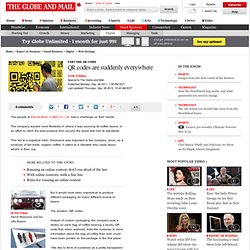

Interactive Bulletin Boards - Guest Post. As my students have transitioned more and more into creating digital projects over the last few years, I have struggled with ways to showcase their work in a community that does not always possess the tools to access the World Wide Web.

Lately, I’ve been playing with the idea of bringing together the digital and “real” worlds in their projects. My students yearn for outside feedback, but rarely get it when they post their work on a blog or in an Internet gallery. Thus, after reading a post about Transliteracy, my Interactive Bulletin Board was born.Using a project from Read Write Think about Parallel Poems and an art project from Princeton Online, the students had a beautiful 2-D Bulletin Board to display in our hallway.
But, I wanted to bring its viewers into the digital world as well, so I used a few tricks to engage the audience - QR codes, a puzzle, and an iPad. First, I mixed up the artwork and poetry on the board so that they weren’t matched with each other. About the Blogger. How to Help QR Codes Catch On. When it comes to QR codes, people seem to either love them or hate them.

Marketers usually think they are either the holy grail or the plague. The QR-lovers argue that they are still in their infancy in the United States and just need more time to be adopted by the masses. Those on the opposite side argue that they will never catch on because the "work" of scanning a QR code on a smartphone and the reward granted are not balanced.
Well, I think both sides are right. As they are used now, QR codes won't last. Are you rooting for QR codes? QR codes are suddenly everywhere. The people at Ethical Bean Coffee Co.

Ltd. had a challenge on their hands. The company wanted more flexibility in where it was sourcing its coffee beans, in an effort to catch the best produce from around the world that met its standards. This led to a logistical hitch: Disclosure was important to the company, since, as a producer of fair-trade, organic coffee, it caters to a clientele who cares about what’s in their cup. But it would have been impractical to produce different packaging for every different source of beans. The solution: QR codes. Instead of custom packaging, the company puts a sticker on each bag of coffee bearing a blocky QR code that, when scanned, links the customer to more information about the bag of coffee than ever could have been printed on the package in the first place. “We like to think of ourselves as a pretty transparent company,” says Viren Malik, chief operating officer of the Vancouver-based firm. QR codes have gone from obscurity to ubiquity in a hurry. Where not to use QR codes.
Leave it to the Toronto Transit Commission.

In its eagerness to reach out to riders, the transit authority has mounted ads that urge residents to contact it by phone, in person, online – and even by QR code, printed right there on the ad. This would be fine, if the ad had not been mounted in a subway car. Toronto’s subways are, if nothing else, good to their name: well and truly underground. And for all the other places in the city you can get the reception you’d need to look up a QR code, it’s not on the subway. There are a lot of reasons to consider QR codes as a marketing tool. They’re cheap to deploy – generating them online is free, and once you’ve sunk the money into the infrastructure to support them in your website’s content management system, there’s no additional cost to send them out. They’re increasingly ubiquitous, meaning that more and more smart phone users have installed scanning software and learned to use it.
There’s some cause for pause. Don’t scare them off.